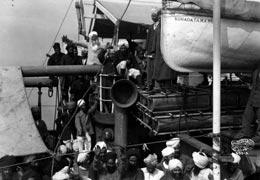Seeking a history I never knew

Alysha Bains,
It felt as if I wasn’t given the chance in school to be curious about how the past has a deep connection to the present. Flipping through the history textbook pages, I would see isolated facts about Canada’s past. Stripped down marginalized histories were clumped together on one page, as if they counted as a single narrative.
The Komagata Maru was a name that I had briefly heard in Social Studies class, but never a narrative that I understood. Images of those on board looked familiar. The South Asian men in the pictures stood tall and proud in their military uniforms and some of them in their dastars (turbans), looked similar to my great grandfather’s photo on my grandmother’s wall, who also stood tall wearing his dastar and military uniform.
In university I became curious about Canadian history and how it connected to my world. As a second-generation South Asian woman, I wondered how issues of race were entangled within Canadian nationhood.I was filled with questions, not only about Canadian nationhood, but about the ways in which Canadian nationhood has been constructed. How did we get here? Why are we so afraid to confront tensions around race, when we are supposedly a ‘post-race’ society?Broken parts of the Komagata Maru were scattered across textbooks and were dispersed throughout various resources. My assumption in my quest to find out more about the Komagata Maru, was that this ‘incident’ lay in the margins of Canadian history, along with many other histories.
It was at the symposium of an SFU library project titled,“Komagata Maru: Continuing the Journey,” where I had the opportunity to understand the Komagata Maru as a Canadian issue and not solely a South Asian one. I felt inspired after I heard various people from the community including scholars, poets, and researchers speaking to the issue. I filled a notebook with ideas that stayed with me while I embarked on a research project that became much more than an academic endeavor.
This experience at the symposium drove me to investigate the ways in which the Komagata Maru has been traditionally addressed by public institutions in British Columbia. I chose to analyze how the event of the Komagata Maru has been constructed through theVancouver Sunand the BC Social Studies 11 curriculum. Both are institutions of knowledge formation and knowledge transfer, and play a key role in the Canadian historical memory.
I spent a year analyzing the history of the Komagata Maru. It was a history that I never knew, that was filled with struggle, courage, and the sacrifices of a resilient community. While I was immersed in my research, questions surrounding identity began pouring through my mind.
I saw a pattern across all findings that the overt ideology of ‘white’ Canada that existed in 1914, exists implicitly in the present day by using oppressive frameworks when discussing Canadian nationhood. It was overwhelming to see how the Komagata Maru had been constructed as a marginal issue that was not appropriately addressed or taken up by Canadian discourses.
What I found was that systems of public learning are not bridging us to together in the compelling ways that they should be. I see the systems of learning infringing on the meaningful connections that should be happening in our community.
Community events, exhibits, and resources like www.komagatamarujourney.caare giving us opportunities to refocus an issue that has existed in the margins of Canadian nationhood for a century. The Komagata Maru is a story about challenging racist ideologies and a remarkable community that sought freedom. This history is a significant part of how we understand ourselves and identify with one another; it cannot be contained or isolated.
Leave a comment









